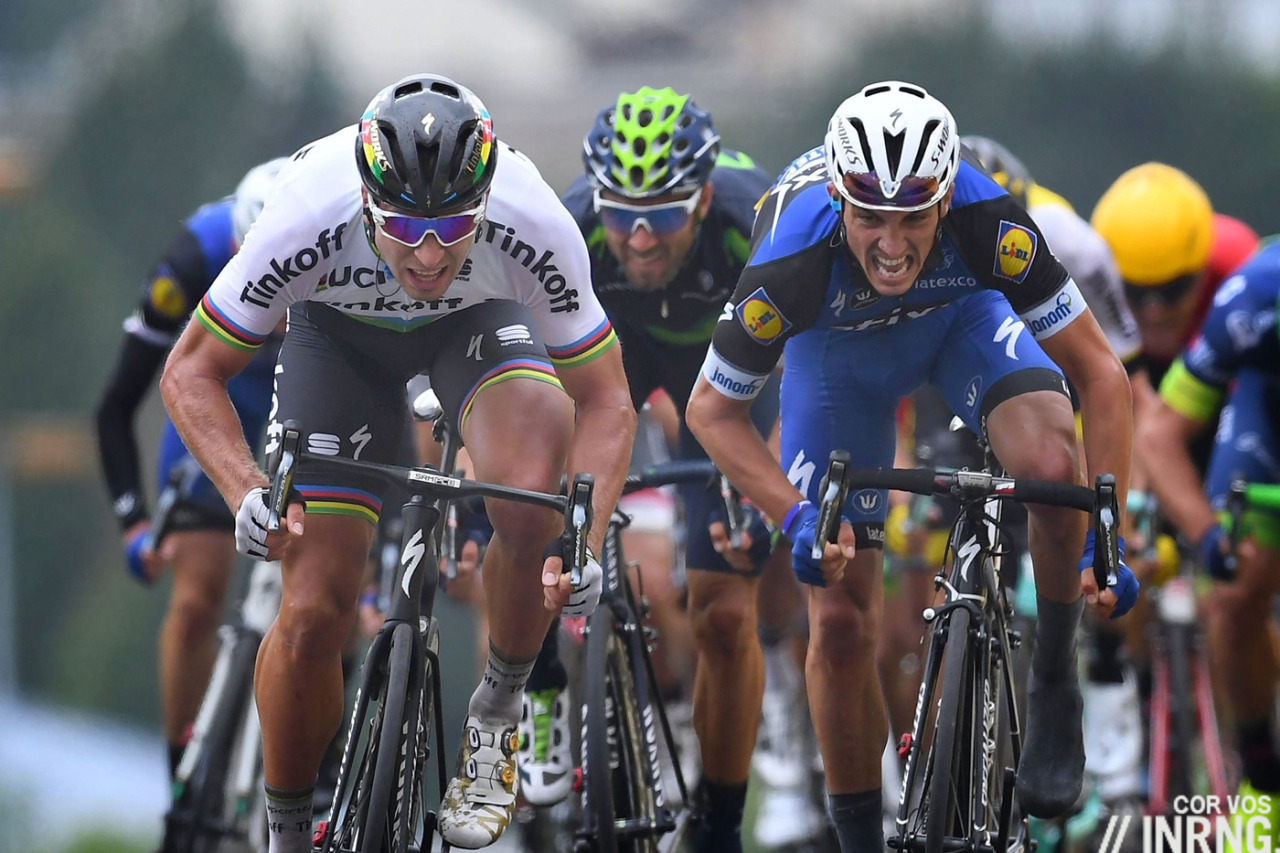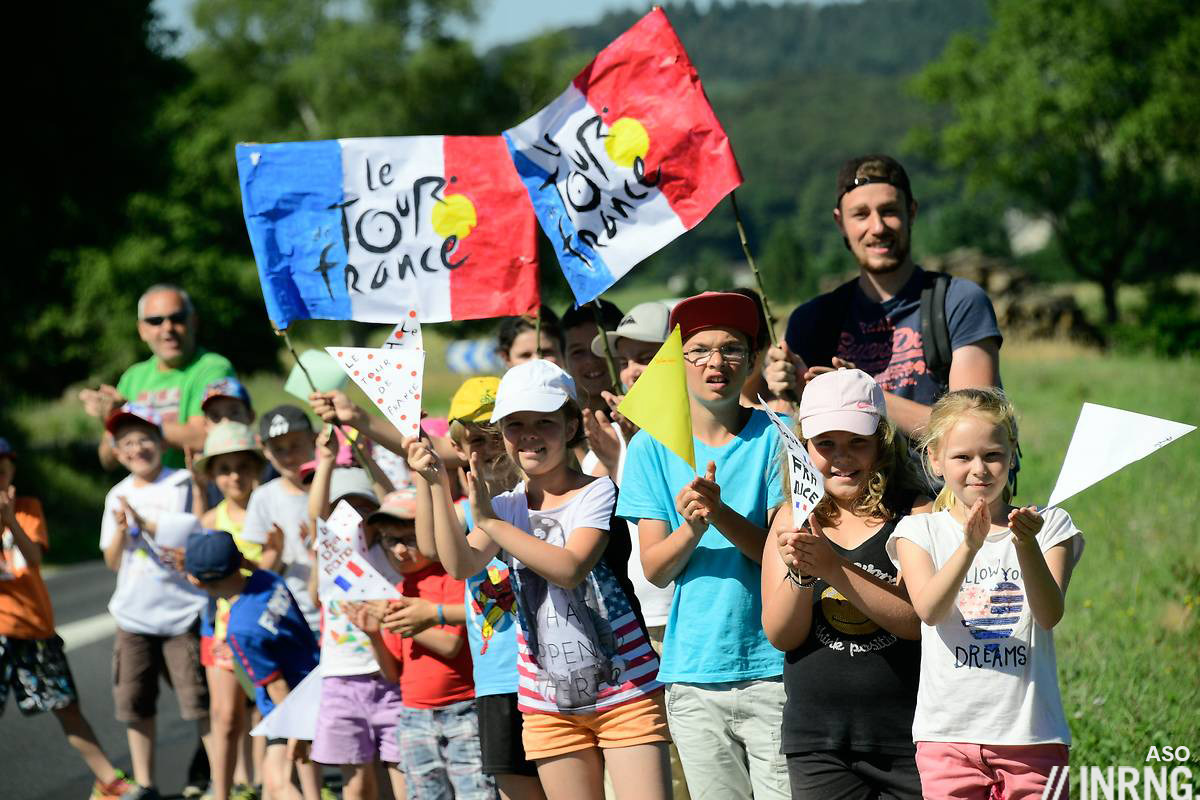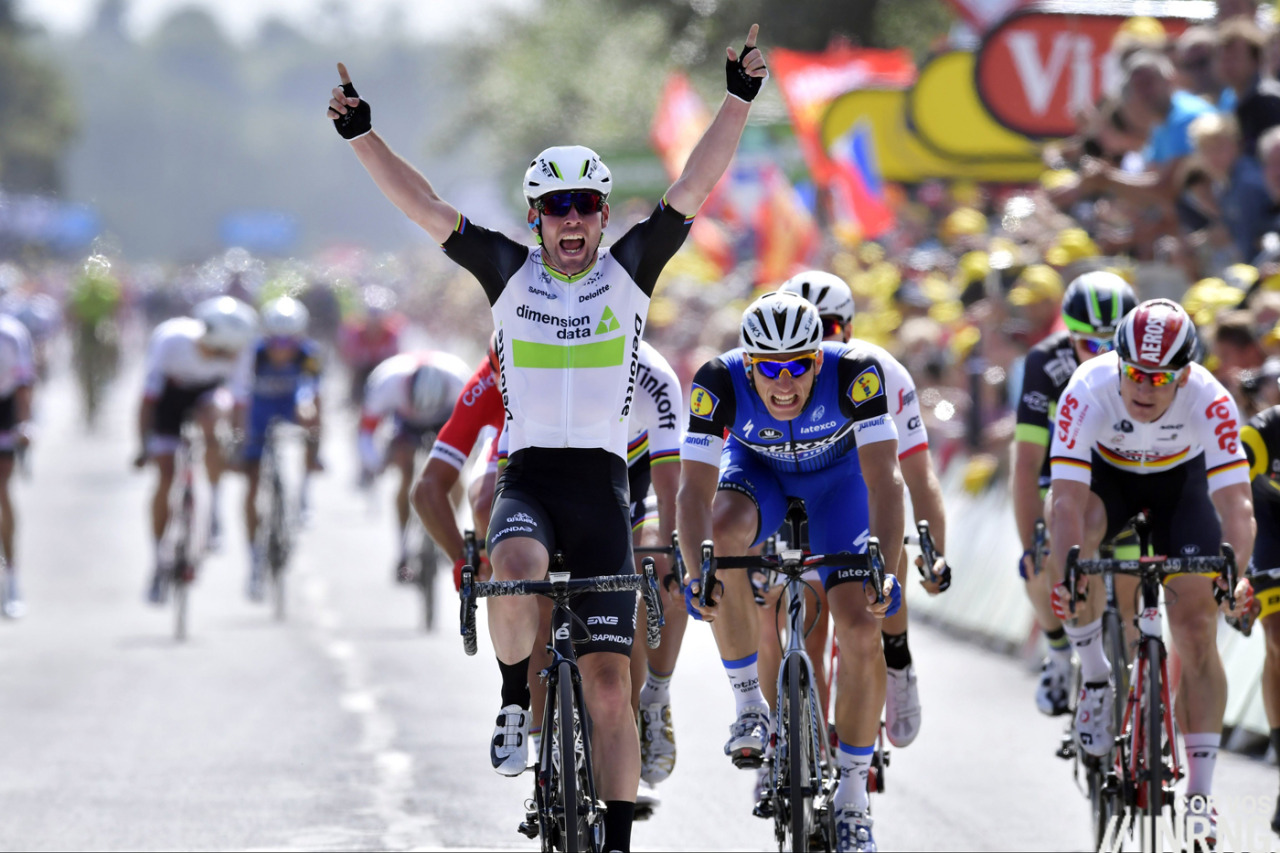Want to host the Tour de France? If so then France’s state auditor the Cour des Comptes, “the court of accounts”, has issued a report into le grand départ from 2016 that gives us acloser look at the finances, business and practicalities of hosting the Tour de France.
Intro facts: The start of the 2016 Tour de France was held in the Manche départment in northern France in the Normandy region. It was this department that was the host of the event and it created an organising body called “La Manche – Ouest Normandie – Grand Départ Tour de France 2016” (LM-ON-TdF) to run the grand départ. The opening stage at Utah Beach was won by Mark Cavendish with Peter Sagan winning the uphill finish on the edge of Cherbourg the next day. The Tour is run by Amaury Sport Organisation (ASO), a French business owned by the Amaury family.
Bid timing: the Manche first submitted its bid to host the Tour de France in 2012 and this was accepted in 2014 for the 2016 edition. This shows a relatively brief calendar with four years from bidding to hosting, a shorter cycle than other big sporting events but reasonable given the race is only visiting for a weekend.
Goal: the bid and the work of LM-ON-TdF was (translated):
“to suggest a range of measures… …to engage residents, attract tourists, bring in traders, entrepreneurs, local bodies, charities, federations and local sports bodies as well as the wider public”
Note the verbs rather than measurable targets and it’s here we see the first criticism from the Cour des Comptes as it states these aims are vague and undefined.
Hosting fee: LM-ON-TdF had to pay ASO’s fee of €2.4 million and on top of this arrange various installations like the press room, toilet facilities for spectators and provide a ready area for the finish line and podium facilities.
The Cour des Comptes says the hosting fee is hard to evaluate because it is not public but cites other starts: €10 million for London 2007; Corsica in 2013 paid €2 million; Utrecht 2015 was €4 million; Düsseldorf paid €6 million last year.
Staff: at its height in June 2016 15 staff were working for LM-ON-TdF, including 5 stagiaires (interns) and they worked on logistics, communication, promotion and another 700 volunteers on top, including 250 for the opening ceremony.
Opening ceremony: LM-ON-TdF outsourced the opening ceremony where the teams are paraded on stage to a third party and paid €206,000.
Budget breakdown: ASO’s €2.4 million fee was the largest item followed by €1.6 million on public relations and communication, €0.5 million on staff costs, then other incidental costs for a total cost of €5.3 million. This was funded by France’s layercake of local government with the Normandy region (€1.3m), Manche department (€2.9m) and local communes (€0.8m) paying in too as well as some small additional income from local sponsors and hospitality sales.
Local sponsors: ASO has a clause that the grand départ can have additional sponsors to those brought by ASO itself (LCL, Skoda, Vittel etc) but they must not be competitors of race’s existing sponsors and LM-ON-TdF has to pay an additional fee of €100,000 to ASO if outside sponsorship happens (a one-off flat fee, not per sponsor). The Cour des Comptes says this six figure hurdle put a brake on finding local sponsors, by extension the income generated had to be substantial to make it worthwhile for LM-ON-TdF beyond the fee. Brittany Ferries and a local dairy producer became sponsors.

Extra costs: the €5.4 million figure is only for the direct hosting, there are other costs involved such as resurfacing the roads and sprucing up villages and other spots along the road. Cherbourg spent €340,000 on roadworks for the stage finish where Ritchie Porte punctured and struggled for team mates before Peter Sagan beat Julian Alaphilippe and Alejandro Valverde. Like counting the spectators what portion of roads resurfaced would be redone without the race’s visit isn’t clear.
Spectators: there were 878 444 spectators according to a study by Orange, France’s telecoms operator which measured the flow of people via the mobile phone network and then made some assumptions and extrapolations so don’t count to the nearest person. Here’s the breakdown anyway:

Of the foreign visitors, 29% came from the UK, 19% from Germany and 11% from Belgium. But how many of these were drawn by the Tour and how many were simply in the area and happened across the race? The auditor says this is not clear and a comparison between the same zone and the previous year would be useful.
Spectator spending: LM-ON-TdF estimates the spectators spent €22.6 million based on the assumption of an average spend of €32 for a day tripper, €74 for others based on a marketing study by TNS-Sofres, an agency, on tourism in France from 2013. This income to expenditure ratio of 4:1 is in line with previous Tour de France starts like Corsica and doesn’t include spending from the 4,500 people following the Tour de France (team staff, media, workers etc).
Media coverage: the race gets big coverage with claims of 190 countries showing it but how much of this is actual live coverage versus a 20 second “the Tour de France started today” package in a news bulletin is anyone’s guess. The Cour des Comptes notes that some of the coverage in the regional press was bought and paid for by the local department.

Conclusion: want to host the start of the Tour de France? You’ll need a few million Euros to spare but get your bid together and it could happen within four to five years. Be prepared to accept ASO’s terms and conditions and then set aside money for local events and road repairs on top too. It’s costly but seems positively Keynesian bringing in an estimated four to five times the spend and ensures beaucoup media coverage. Plus if you’re the mayor or regional patron you’ll be on the podium to meet and greet the stage winner and yellow jersey.
- A parting thought: you need something to flaunt and the right weather. Many will have wowed at the scenery and sunshine in Corsica and thought of visiting but last July’s Düsseldorf start was a damp squib.
Source: https://www.ccomptes.fr/fr/documents/41284


Fascinating insight as always!
It’s interesting to see how much the hosting fee varies. Perhaps you wouldn’t expect a small region of France to be able to fork out as much as one of the big international cities, but the variation is still quite intriguing. Does this purely come down to a bidding process i.e. how much the cities are willing to pay? It’s an interesting topic, especially given the grande partenza of the Giro this year and the size of the payments rumoured from Israel.
As a side-note, London were supposedly front-runners to host the Grand Depart of the the Tour last year (2017) but the plans were abandoned at the last minute by the then mayor, citing the overbearing cost of hosting the event; that seemed to happen less than 2 years prior to the event so Dusseldorf must have had a very quick and efficient organisation. No doubt there are much greater costs and arguably smaller benefits of a large city hosting it compared to a smaller region.
https://www.theguardian.com/sport/2015/sep/29/boris-johnson-explains-londons-decision-to-turn-down-tour-de-france
I don’t see how the event “brings in” all this income if roughly half the spectators live in the area. Surely their spending is money that they would have spent in the area anyway?
Perhaps it’s people leaving their homes to go out, bringing picnic foods that they would not have otherwise bought etc?
Bar and restaurant bookings for an additional 230000 visitors on day one, as well as 96000 overnight hotel/bed and breakfast guests would have been a massive boost for the local economy.
Using numbers that I’ve picked out of the air, 10 euros per tourist/daytripper for drinks/beer/food (2300000 euros) and 30 euros per overnighters assuming sharing etc, (2880000 euros), for a total of 5.18m euros of additional local revenue on day 1.
This doesn’t take into account local spending,
Additional benefits of boosting tourism for future, as well as promoting local AOC products (cheese, cider, etc)
It’s a case of the seen and the unseen. We can see what people spent, but we don’t know how they would have spent their money otherwise, or how their money might have been used if they left it in the bank.
Against which you have to balance, e.g., those who would have gone in to Cherbourg to do some shopping, but decided not to because they thought the Tour would cause congestion.
Don’t get me wrong, there’s definitely a boost, as people come into an area who wouldn’t otherwise have come, but sporting organisations and host authorities do have a habit of overstating the benefits by ignoring the spending that would have happened anyway.
I’m not sure that I follow the logic here.
Most of the numbers will be based on year-on-year comparisons, so they will naturally account for spending that would have happened anyway.
That’s what they *should* do, but the original piece implies that they don’t:
“how many of these were drawn by the Tour and how many were simply in the area and happened across the race? The auditor says this is not clear and a comparison between the same zone and the previous year would be useful.”
@Adam – As I explained below, in this case year-on-year figures don’t help much to understand what happened.
@Nick – We can estimate how many the average visitors in July are (or know what the total is), and, on that basis, apparently the added arrivals more than compensate any reduction. At most, we can say that some of them would have gone anyway. But let’s say that the “normal” figure would have been 120K. Thus, imagining that, I don’t know, 20K didn’t go instead of visiting to shop around, it would simply mean that the TdF brought in +100K instead of +80K we might have calculated otherwise.
Nick, I might be wrong but I’d say that local spectators’ expense isn’t included at all in the 22.6M estimate. And I’d bet that, as inrng said, locals will spend some more euros than usual when the TdF is in town.
And, frankly, I even think that average 74 €/day for a person from a different region which stays for the night isn’t an example of overestimated figures. Hotel night, transport and food… not bad. Now I’m more keen on visiting there!
Sure, we don’t know how many would have gone there anyway. Despite the TdF start, 2016 was a bad year for tourism in the zone. The tourism office says that the TdF effect was barely noticeable: their argument is that, although it’s true that July was the first month whose loss in comparison with the previous year was “less horrific”, all the same August was better than July. I’m not sure this is a valid argument, given that we don’t know how bad may July have been in case they hadn’t had the TdF start.
There sure was a positive impact on (above all – it’s very evident) Belgian tourists and German ones (who are the EU top spenders), while it’s less clear if UK tourists really came in for the TdF (they were visiting less than previous years).
However, I’m still surprised by what the Tourism Office says. In July 2016, the global daily average was 20K nights and, if we focus on weekends only, as if the rest of the week didn’t exist (which provides us with an upper limit for the estimation), the average would be 120K nights.
The TdF weekend got clearly over 200K. Should we consider that *business as usual* is the first July weekend being the best one in the month, like, *doubling* the rest? Even way better than the 14th July combo? I really doubt it.
The TdF sure had an effect, and a notable one. What might be argued is that people who’d go anyway to La Manche decided to change their dates in order to take advantage of the Tour, but they’d go there anyway later in the month if the Tour wasn’t there. Perhaps.
I tend to think that July was going to be awful in tourism terms and the Tour helped the zone to save the day (or the month).
Anyway, the main TdF effect was on daytrippers…
All in all, I’d dare to say that the TdF *extra boost* was probably worth some 10-11M at least (and always without considering the extra local expenditure or the middle to long term impact thanks to TV exposure). It’s to be seen – hard to say, given that the existing studies are mainly monthly – if part of those 10-11M was actually “subtracted” to other days of the month. The fact that little difference was to be seen when comparing with the previous year, just as in August, is far from being a definitive argument, albeit an interesting one. June (and the rest of the year, both in Spring and in Autumn) was absolutely awful… August could well have been the only exception. For sure, the TdF changed the setting. Was it about changing your reservation to the first weekend or was it about visiting a region you wouldn’t have gone to, not in 2016 at least?
Maybe seeing the region on TV while watching the Tour in July spurred one to visit the region the next month, August.
Fascinating. Any idea why London had to pay almost four times as much?
There would have been additional costs to bring the race over with the logistics etc but not that much more. Perhaps London just wanted it that much and ASO knew it?
Also Germany is a big target market for ASO so they will reduce the price for the opportunity to reach in to this market. Just as Britain is now but probably wasn’t in 2007. Yorkshire in 2014 seems to have been €4.4 million.
Don’t forget that, at the time, London (and the UK) was very actively promoting cycling and TfL were using the Tour as a driver for its own ends (cycling infrastructure etc).
The legacy 10 years on in London is quite marked.
It may have been expensive, but there would be a good case to state that it was good value for money and perhaps even helped to bring about a cultural change?
I wonder how many people attended the start in Düsseldorf last year, are there any numbers? My impression was that the crowds were huge
Regional tourism departments also have marketing budgets which they will be spending one way or another. Granted that the TdF would require a larger than normal spend but a portion of the cost of a Grand Depart would otherwise be spent by the tourism marketing areas in other ways. Similarly, the expenditure on road works isn’t necessarily in addition to the existing road maintenance budget. It may have been spent anyway but on other roads instead of the ones that the TdF is using. So this government expenditure isn’t necessarily not going to happen if the TdF wasn’t in town. Some of the funds that may otherwise have been spent anyway have been diverted to the purpose of supporting the Grand Depart. Which, of course, should give the locals lots of grist to the mill for arguments about whether the funds were spent on the right things or not, but it’s not all “over and above” what would otherwise be spent.
Positively Keynesian – an oxymoron to me.
I don’t intend any criticism of what is outlined in this article about the monetary value of costs and benefits. Based on my observation of events held in a nearby community and responses within that community, I am adding to comments that a problem can arise when it appears that those in the community who bear the cost of the event are not necessarily the ones who accrue the benefit. In this situation, the final tally of benefit may not matter. It is important that an entire community feel that they are included and feel that there is worth. This poses a real problem for measurement.
You make a fair point. The monetisation of the Tour’s benefits does not take into account (as far as I know) the costs – inconvenience with closed roads, extra traffic, noise and pollution etc.
It should be possible, in theory, to carry out a more truer cost benefit analysis / environmental impact assessment but, of course, that would not fit in with the brief.
And ASO do not (again, as far as I know) pay costs towards the public sector’s responsibilities – waste collection, Policing and security, other emergency services provision etc in the same way that a sport such as football has had to bear.
A very nice post. Incidentally it has also addressed another issue in its second photo of Sagan vs the Quick-Step rider (not sure who):
One advantage of disc brakes is a bigger ‘S’ on the head tube!
I do my $ part, I will try and drink wine from the region “terroir” they race through, that combined with the wonderful HD photojournalism that the various regions provides satisfies me here in California.
I should try that for all the Giro and the Velta…as well.